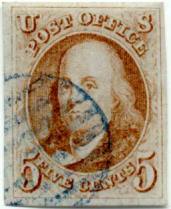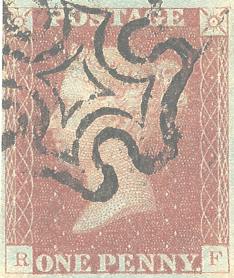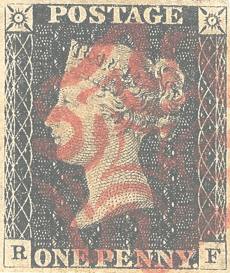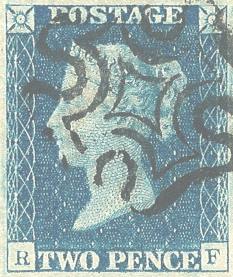|
Selling
Stamps On Ebay
The question that I am asked most often
regarding stamps is “What are my stamps worth?" Once an answer is
forthcoming, it is invariably followed by “how can I best sell them to
maximize value?” For many, the answer to the second question is to
sell them on Ebay. |


The 1847 First Issue of
United States Stamps
|
This may not be as easy as selling
Pez dispensers. Stamp collectors are a very fussy group of buyers and then spend
their money with vendors who take the time to accurately and fully describe
their goods, provide good scans, and offer satisfaction guarantees.
In a recent market survey conducted by Linn’s Stamp they estimated the
total stamp market for the year 1999, in the United States alone, at
$967,000,000 spread among 6,830,000 collectors. So, it is certainly a market
worth trying – if you are willing to spend the time needed to market your
stamps correctly. Who knows, you may end up a collecting them yourself.
The vast majority of stamps have little or no collector value. This applies to
virtually everything your great grand dad tore off his envelopes dating from the
1920’s till now. Now, if he saved the whole envelope, called a “cover,”
you might have some luck. Stamps
that do have value are the ones that were not used to a very large extent.
A Great Britain one penny red stamp issued in 1841 was used for most
domestic mail in Great Britain for several years. It has a value of about $1 in
normal condition. Even the 1840 one penny black, which was the world’s
first postage stamp and was used only for one year, has a normal value of
only $50 or so. However, there was a two penny blue stamp that was also issued
in 1840 to pay the postage on overweight letters. In use for only a year on a
fraction of the total mail sent, it is substantially more valuable at about
$250. Examples of all three are shown below in very fine condition.
 |
 |
 |
| 1d red of 1841
(value $1) |
1d black of 1840
(value $50) |
2d blue of 1840
(value $250) |
Stamps
were printed with 240 different letter combinations in lower corners. These
examples all bear the author’s "RF" initials.
A good first step in selling your stamps on Ebay is to evaluate how much money
was spent building the collection. If little or no money was spent, it is
probably worth very little. If "serious" money was spent, it will almost
certainly be worth more now. Then evaluate how much time you wish to dedicate to
selling your stamps. It will be necessary to buy, or find at the library, the
needed catalogs (most United States collectors use Scott’s catalog), learn how
to correctly use the catalog, absorb some of the technical language, before you
can become an effective stamp seller on Ebay. An alternate solution is to find
an auction house to sell your stamps for you. At this time, very few of the
traditional auction houses have instituted Internet auction sites.
If you need assistance in stamp identification, or want to find Internet
resources available to you, a good starting point would be to check out the
famous yellow boxes
compiled by members of the Ebay Users Stamp Club. This site provides links to a
wide variety of valuable information as well as recommendations as to literature
needed. Also, Frajola's board
for philatelists is inhabited my some of the most knowledgeable, and
helpful, people you will find anywhere on the internet.
The advantages of selling stamps on Ebay are greatest in the lower value
segments of the market. I have tried to encapsulate my experience in the
following summary.
The
Value Propositions For Buying And Selling Stamps On Ebay
Stamps are perfectly suited to Internet auctions. There is a long history of
stamps being sold at traditional public auctions, which is important because
collectors are already used to bidding competitively when material becomes
available. Also, because certain conventions of description and cataloging are
accepted around the world, a wide audience will understand a description of a
stamp. Stamps are in strong demand from a wide range of potential bidders and
the Internet allows for cost effective cross marketing to a larger audience than
is otherwise reachable. And finally stamps are an easily shipped product. So,
how well does ebay service this segment of the collectible market?
To evaluate this I have
chosen to segregate the stamp market into discreet units by the dollar level of
goods offered.
Value Propositions
for items valued under $25.
1.
For seller - good – likely to extract nearly full value.
Traditional stamp auctions cannot afford to run, let alone photograph,
individual lots in this price range because of cost considerations.
Many times items bring more than they should because of cross marketing.
For example, a sheet of common Pharmacy stamps might bring well more than face
value because a real life Pharmacist might decide it would look nice framed over
his counter.
2.
For buyer – usually good – likely to find items of interest
that would otherwise be available only at a far away dealer bourse or my mail at
higher dealer retail prices. Some danger in getting goods that are not as
described because oftentimes the sellers of this level of stamps donÂ’t catalog
items correctly.
Value Propositions for items valued $25 to $100.
1.
For seller – fair – likely to extract 70% of full value if you
have a solid reputation. The bulk of the buyers in this range are relatively
sophisticated. They require good scans, a return privilege, accurate and
detailed descriptions, and discount their bids for a seller of unproven status.
2.
For buyer – good – once they can quickly and accurately
eliminate the miss-described goods that are prevalent in this price range. The
patient and knowledgeable collector can be rewarded with good bargains.
Value Propositions for
items valued $100 to $1,000.
1.
For seller – poor – probably will be lucky to get 60% of
value. Even with a solid reputation and feedback record the buyers at this level
discount their bids expecting something to be not as described. The best of the
current ebay vendors are rarely as reliable as the worst of the traditional
auction houses in describing faults accurately. As a result the buyers tend to
favor the traditional auction houses.
2.
For buyer – poor – there are a tremendous number of
incorrectly described items appearing at this price level. The largest stamp
vendors that inhabit this space often make their profit by exploiting the price
differences between the faulty goods they buy and fault free goods they sell.
Value Proposition for
items valued over $1,000.
1.
For seller – horrible – other than collection offerings with
lots of scans, I have seen virtually nothing priced over $1,000 in Ebay stamps
category that realized even close to real value. This is likely due to lack of
bidder confidence in the accuracy of seller description. Also, many of the stamp
buyers for this range of material are not yet on the Internet.
2.
For buyer – horrible- most of the goods in this range are not as
described or reserved at levels that would not otherwise be supported.
Richard
Frajola (May, 2000)







